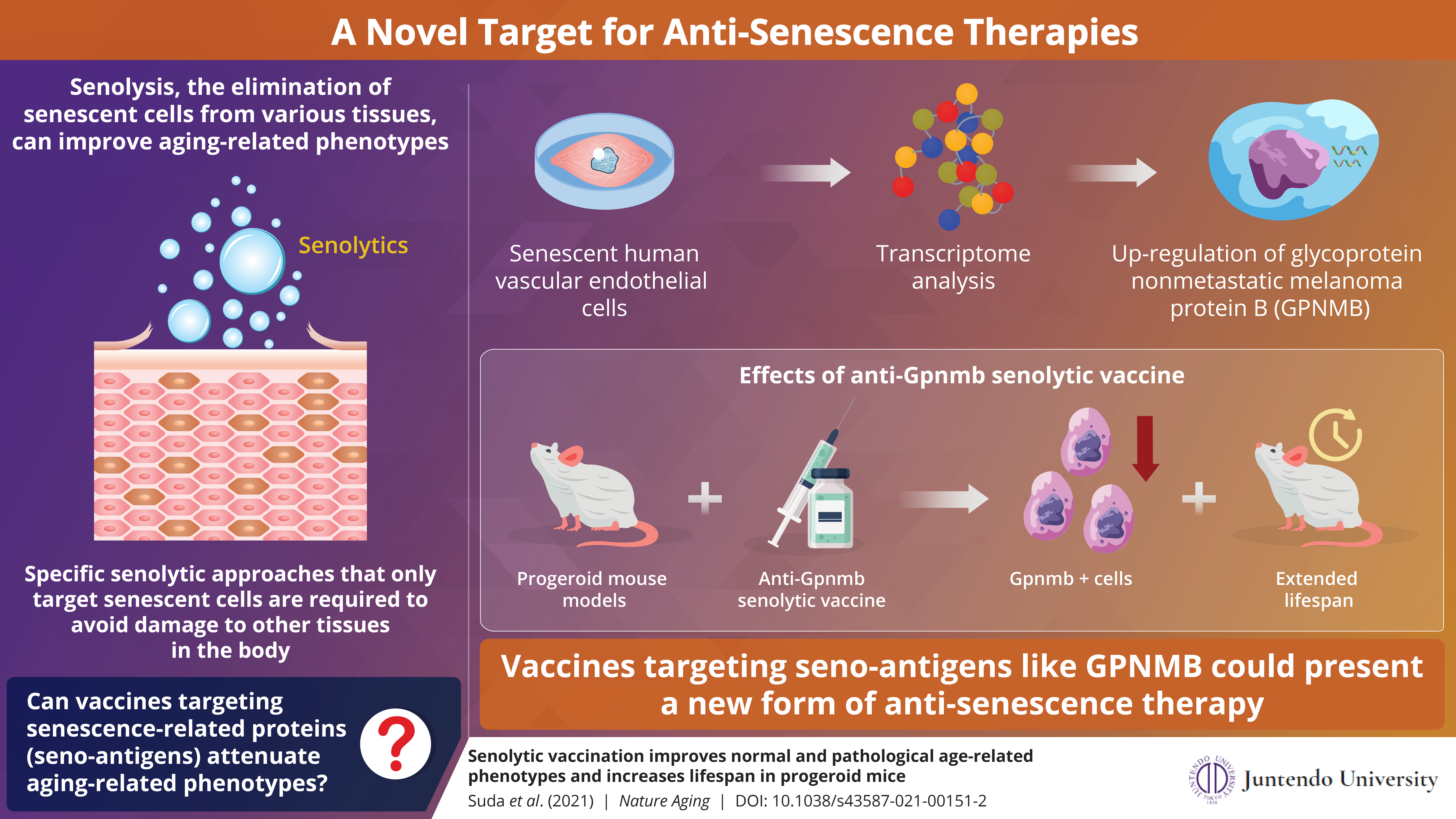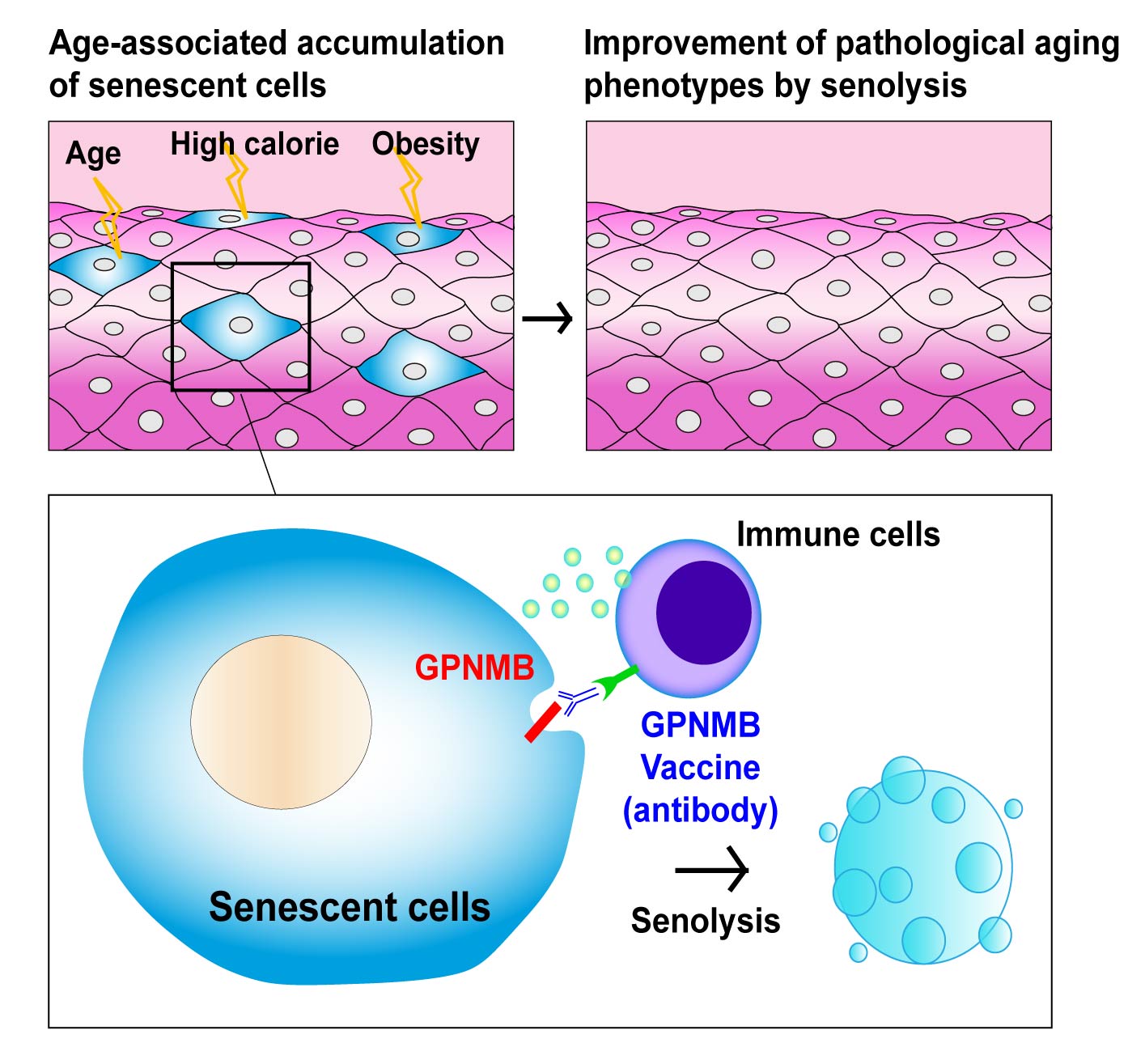Jan. 15, Sat, 2022
Topics
>RESEARCH
Stop the Clock: New Therapeutic Strategy Targets “Old” Cells to Prevent Ageing
Scientists have developed a vaccine for a new drug target expressed exclusively by certain “senescent” cells, paving the way for anti-aging therapies

The accumulation of senescent cells leads to age-related impairments and diseases. So far, there have been no treatments that can exclusively target these senescent cells. Now, in an exciting new development, researchers have developed a vaccine specific to a protein found in senescent cells, thereby allowing their targeted elimination. The discovery paves the way towards a strategy to combat ageing and age-related diseases.
Extending lifespan has always been the holy grail of medical research. Although life expectancy has improved considerably, aging and age-related diseases continue to affect billions of individuals worldwide. Aging is primarily caused by the accumulation of poorly functional “senescent” cells (old cells that no longer proliferate) in various tissues and organs. As such, the elimination of senescent cells can prevent aging and age-related disorders, including atherosclerosis, dementia, and glaucoma. However, treatments that target these cells could potentially damage other parts of the body. Thus far, a technique which will allow the exclusive elimination of senescent cells has remained elusive.
Now, researchers from Japan have found that the answer may have been hidden in plain sight all along. In their new study published in Nature Aging, they developed a vaccine against senescent cells using a protein that is only expressed by these cells. Then, they used this vaccine to eliminate senescent cells in mice and observed significant improvements in both the normal and disease-causing effects of aging. According to corresponding author Professor Tohru Minamino of the Juntendo University Graduate School of Medicine, who has studied cellular senescence for over two decades, “With age and metabolic stress, cells become senescent and lose function. We wanted to find an effective and efficient way to get rid of these cells and improve overall tissue function.”
The goal firmly in sight, Prof. Minamino and the rest of the team—including Dr. Masayoshi Suda, also from Juntendo University Graduate School of Medicine—set out to first identify the proteins expressed only by of senescent cells. Using a technique called transcriptome analysis, they examined gene expression in senescent human cells and found that glycoprotein nonmetastatic melanoma protein B (GPNMB) was expressed at high levels in senescent cells. This protein also had high expression levels in cells obtained patients with atherosclerosis, a senescence-related disease involving plaque build-up and blockage in arteries. These findings confirmed that GPNMB was a senescence-specific protein, i.e., a “seno-antigen.”
With the first flag in the ground, the research team went on to understand the effects of eliminating GPNMB-expressing cells using a set of genetic tools. They created mouse models with a genetic modification that allowed them to selectively target and eliminate GPNMB-expressing cells. They found that the elimination of GPNMB-expressing cells in these mice considerably reduced molecular markers of aging and metabolic abnormalities. Moreover, these mice also showed improved atherosclerotic symptoms.
Encouraged by these findings, the research team developed a vaccine specific for GPNMB. “We found anti-aging or ‘senolytic’ effects after eliminating GPNMB-expressing cells. But genetic elimination is not feasible in humans. Hence, a vaccine that could target GPNMB and destroy only GPNMB-expressing cells was developed,” explains Prof. Minamino. Next, they tested the effectiveness of this vaccine in three mouse models: normal young mice with a high-fat diet, normal older mice (50 weeks old), and a mouse model of progeria—a disease that causes accelerated aging. They found a reduction in metabolic dysfunction in normal mice immunized with the senolytic vaccine. Moreover, they found that the older mice who received the vaccine showed fewer age-related motor and functional impairments. Most importantly, progeroid mice who received the anti-GPNMB vaccine showed longer survival durations, and male progeroid mice in particular showed an extended lifespan.
Together, the findings from their experiments confirmed the effectiveness of the anti-GPNMB senolytic vaccine in preventing the physical, metabolic, and disease-causing effects of senescence. Their results highlight the exciting potential of seno-antigen-based vaccines in new senolytic therapies.
According to Prof. Minamino, this is but a small step in a long journey ahead, “Our study has demonstrated the possibility of a new anti-senescence strategy. We speculate that there are many more seno-antigens that are produced by other kinds of senescent cells. With more research we will be able to provide individualized anti-senescence therapy for patients depending on the prevalence of different types of senescent cells in their body.”
Thanks to these groundbreaking findings, age-related illnesses like dementia could some day be a thing of the past!
Reference
| Authors | Masayoshi Suda1, Ippei Shimizu1, Goro Katsuumi1, Yohko Yoshida1, Yuka Hayashi2, Ryutaro Ikegami2, Naomi Matsumoto3, Yutaka Yoshida4, Ryuta Mikawa5, Akihiro Katayama6, Jun Wada6, Masahide Seki7, Yutaka Suzuki7, Atsushi Iwama8, Hironori Nakagami9, Ayako Nagasawa10, Ryuichi Morishita11, Masataka Sugimoto5, Shujiro Okuda12, Masanori Tsuchida10, Kazuyuki Ozaki2, Mayumi Nakanishi-Matsui3, and Tohru Minamino1, 2, 13 |
| Title of original paper | Senolytic vaccination improves normal and pathological age-related phenotypes and increases lifespan in progeroid mice |
| Journal | Nature Aging |
| DOI | 10.1038/s43587-021-00151-2 |
| Affiliations | 1Department of Cardiovascular Biology and Medicine, Juntendo
University Graduate School of Medicine, Tokyo 113-8421, Japan
2Department of Cardiovascular Biology and Medicine, Niigata University Graduate School of Medical and Dental Sciences, Niigata 951-8510, Japan 3Division of Biochemistry, School of Pharmacy, Iwate Medical University, Iwate 028-3694, Japan 4Department of Structural Pathology, Kidney Research Center, Niigata University Graduate School of Medical and Dental Sciences, Niigata 951-8510, Japan 5Research Institute, National Center for Geriatrics and Gerontology, Aichi 474-8511, Japan. 6Department of Nephrology, Rheumatology, Endocrinology and Metabolism, Okayama University Graduate School of Medicine, Dentistry and Pharmaceutical Sciences, Okayama 700-8558, Japan. 7Department of Computational Biology and Medical Sciences, Graduate School of Frontier Sciences, The University of Tokyo, Chiba 277-8561, Japan. 8Division of Stem Cell and Molecular Medicine, Center for Stem Cell Biology and Regenerative Medicine, The Institute of Medical Science, The University of Tokyo, Tokyo 108-8639, Japan. 9Department of Health Development and Medicine, Graduate School of Medicine, Osaka University, Osaka 565-0871, Japan. 10Department of Thoracic and Cardiovascular Surgery, Niigata University Graduate School of Medical and Dental Sciences, Niigata 951-8510, Japan. 11Department of Clinical Gene Therapy, Osaka University Graduate School of Medicine, Osaka 565-0871, Japan. 12Division of Bioinformatics, Niigata University Graduate School of Medical and Dental Sciences, Niigata 951-8510, Japan 13Japan Agency for Medical Research and Development-Core Research for Evolutionary Medical Science and Technology (AMED-CREST), Japan Agency for Medical Research and Development, Tokyo, Japan. |
| Latest Article Publication Date | N/A |
| Method of Research | Experimental study |
| Subject of Research | Animals |
| Conflict of Interest Statement | The authors declare no competing interests. |

Scientists have developed a vaccine specific to a protein found in senescent (old) cells, for targeted elimination.
Age or metabolic stress promotes accumulation of senescent cells in tissues that causes pathological aging “phenotypes”. GPNMB vaccination produces an antibody specific for GPNMB, thereby eliminating GPNMB-positive senescent cells and improving pathological aging phenotypes.
Image courtesy: Tohru Minamino from Juntendo University
Age or metabolic stress promotes accumulation of senescent cells in tissues that causes pathological aging “phenotypes”. GPNMB vaccination produces an antibody specific for GPNMB, thereby eliminating GPNMB-positive senescent cells and improving pathological aging phenotypes.
Image courtesy: Tohru Minamino from Juntendo University
About Professor Tohru Minamino from Juntendo University
Professor Tohru Minamino is the Chairman of the Department of Cardiovascular Biology and Medicine, Juntendo University Graduate School of Medicine. He received his MD from the Chiba University Graduate School of Medicine in 1989 and his PhD from the University of Tokyo in 1997. His research focuses on the molecular mechanisms of aging, and especially the metabolic pathways involved in longevity and senolysis. He has published more than 100 papers across highly reputed journals, and his honors include the Satoh Memorial Award from the Japanese Circulation Society as well as the Erwin von Bälz Award.Media Contact
Takeshi Matsuura, Public Relations Division, General Affairs Department, Juntendo UniversityEmail: pr@juntendo.ac.jp
Dr. Yoshitaka Nakashima, Research Promotion Center, Juntendo University